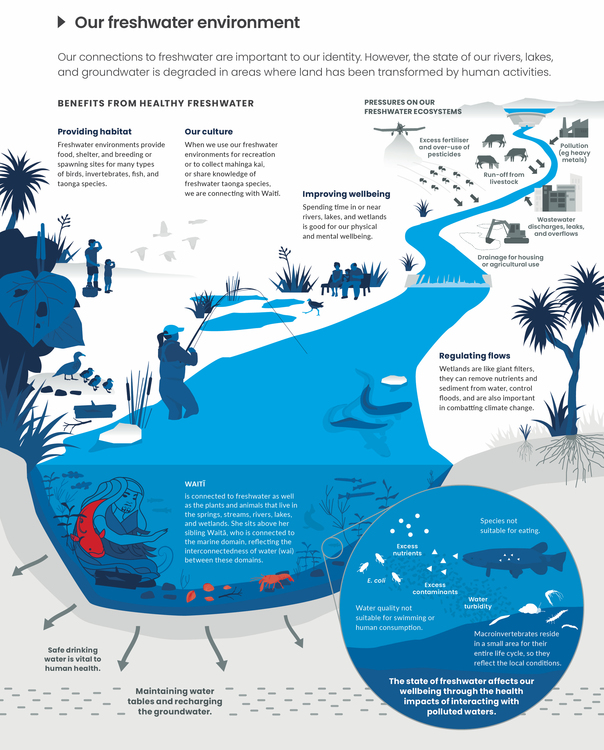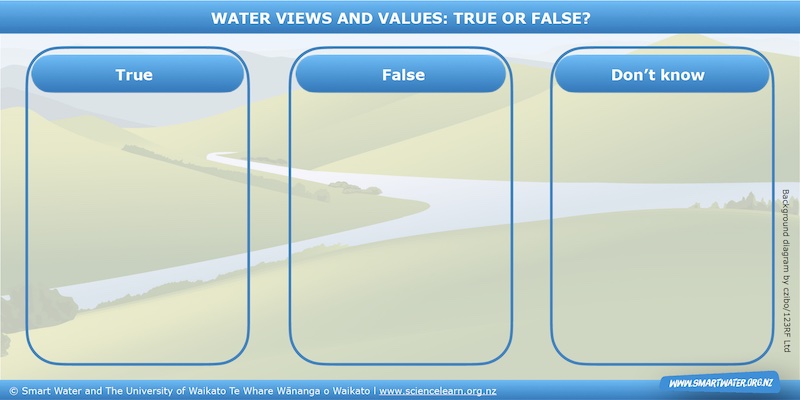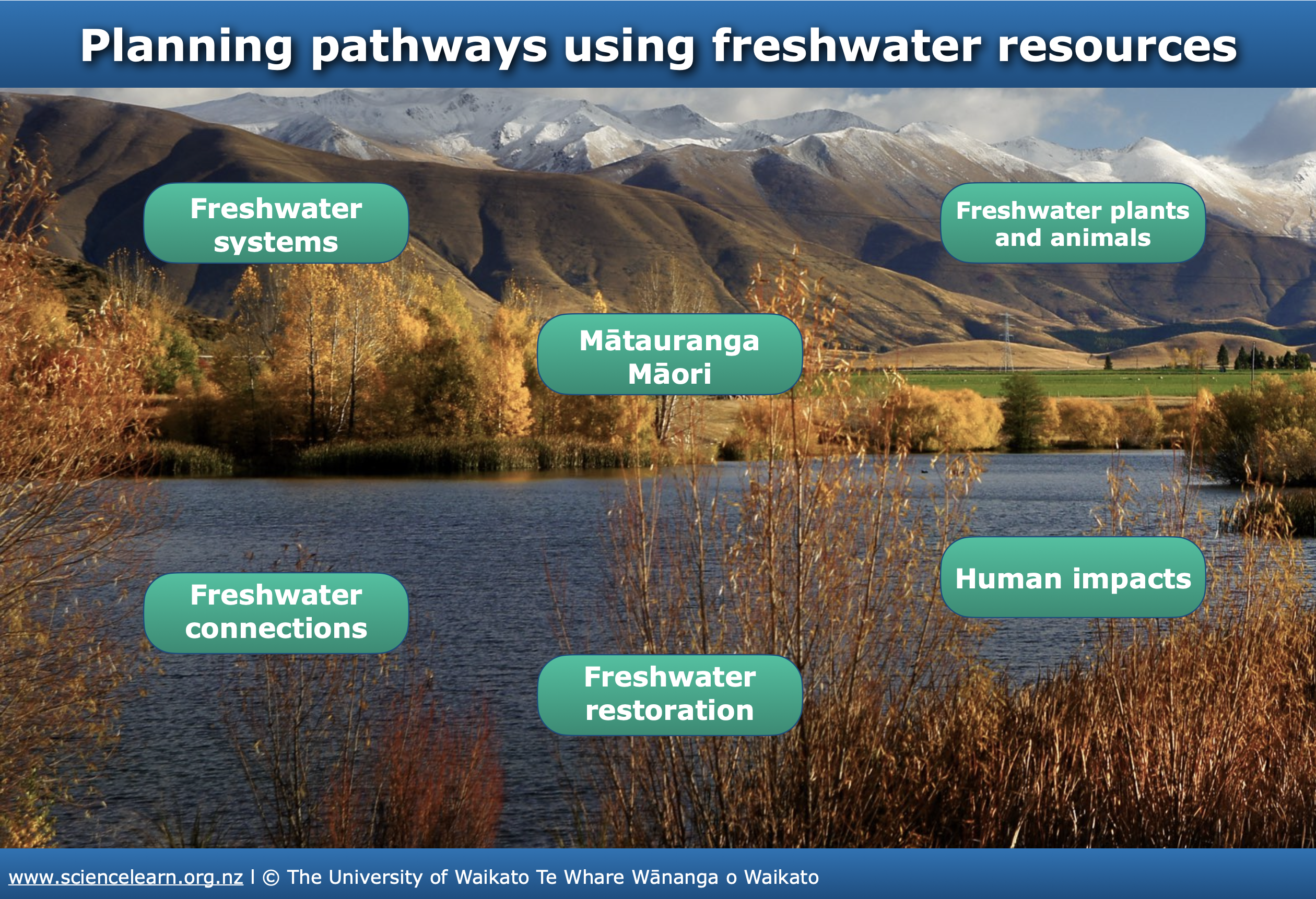Freshwater is defined as inland water – springs, streams, rivers, lakes and wetlands. It includes water that is stored in glaciers and under the ground within soil and in aquifers. Freshwater is part of the water cycle, which is in turn part of the Earth system.
Freshwater connections
Freshwater is a big topic – there are many starting points for context-based learning, and most are underpinned by the concept of connections.
Connecting to place – mātaiahikā
Aotearoa New Zealand is fortunate to have a significant amount of freshwater – most learning centres will have a local stream, river, lake or wetland located nearby. Making use of a local water body fosters ākonga’s connection to place and to those who live in and care for the natural world within the rohe. It creates opportunities for ākonga to connect with tangata whenua as kaitiaki and fosters connections within the community. It also provides opportunities for learning and action that is responsive to local situations.
The activity Exploring my local lake has suggestions for connecting to a local freshwater body virtually or in person. Use it as a framework to explore other freshwater options. Titiro – observing my environment is also useful for gathering information about the local environment.
Interconnected systems
The natural world is highly interconnected. Freshwater is a component of many of the Earth’s systems, spanning the atmosphere, the living world and the physical Earth. This concept is sometimes referred to as ki uta ki tai (from the mountains to the sea) – the interconnectedness of freshwater systems, catchments and the life they support. Freshwater ecosystems can be viewed as catchment areas that create unique habitats for plants, animals and other living organisms.
In mātauranga Māori accounts of natural systems, people are typically positioned inside the system as an interconnected part. Because we are part of these systems, everything we do has impacts. The articles Our freshwater 2023 and Waitī – freshwater environments briefly describe the pressures on freshwater systems, their current states and the impacts this has on environmental and human wellbeing.
Connections across multiple learning areas – mātaiaho
Learning about freshwater systems spans multiple learning areas, including science, health, social sciences, mātauranga, environmental education and sustainability. Umbrella concepts like wai ora (water as a resource that provides sustenance for life) and te mana o te wai (the first right for water being with the water) provide provocations for cross-curricular learning. Where water was once viewed as a commodity by some parts of society, many now recognise that the mauri or wellbeing of water (water quality) is crucial for the wellbeing of the ecosystem, human health and the economy.
Interactive planning pathways
The planning map below provides a gateway to collections of articles, multimedia and student activities grouped by common themes or contexts. By using a combination of these resources, teachers can combine conceptual understanding and capabilities development into relevant learning experiences.
Science capabilities
Learning about freshwater offers opportunities to use and strengthen students’ science capabilities. Environmental reporting like Our freshwater 2023 and Waitī – freshwater environments uses data gathered by science and mātauranga Māori as evidence of the impacts humans have on freshwater environments. Many of the articles and activities have diagrams for ākonga to analyse and interpret. There are also many opportunities to engage with science and even take action within the local community. This last aspect – the ability to get involved and take positive action – is an important way to support ākonga to feel empowered and to avoid becoming overwhelmed by the state of some freshwater systems in Aotearoa.
Related content
The planning pathways featured in this article have a selection of resources on freshwater. Explore the freshwater topic for additional materials.
The Hub has extensive resources on water quality and freshwater ecosystem restoration. Explore these curations:
- Rivers and Us – introduction – exploring how people use water, the effects on water quality and investigation and data collection to inform action.
- Tōku awa koiora – introduction – exploring the restoration of the Waikato River.
- Repo (wetlands) – a context for learning – exploring ecological and cultural values and taking action to understand, protect or restore local repo.
- Tuihonoa Te Reo o Te Repo – he kohinga rauemi pāhekoheko a Tuihonoa Te Reo o Te Repo hei āwhina i ngā kaiako ki te whakatītina i ngā ākonga kia tū hei kaitiaki mō ngā repo. E whai ana hoki kia tū tiketike mai te mātauranga Māori, mā roto i ngā mahi whakaora taiao.
- New Zealand’s freshwater fish – introduction – exploring our unique native fish, their habitats and suggestions on what we can do to help conserve this taonga (resources in te reo Māori and English).
- Lakes380 – Our lakes’ health: past, present, future – find out about the largest scientific study ever undertaken of lakes in Aotearoa.
Explore the range of resources in our Freshwater – lakes and rivers Pinterest board.
Useful link
Stats NZ and the Ministry for the Environment report on different aspects of Aotearoa New Zealand’s environment every 6 months. Access the reports here.



